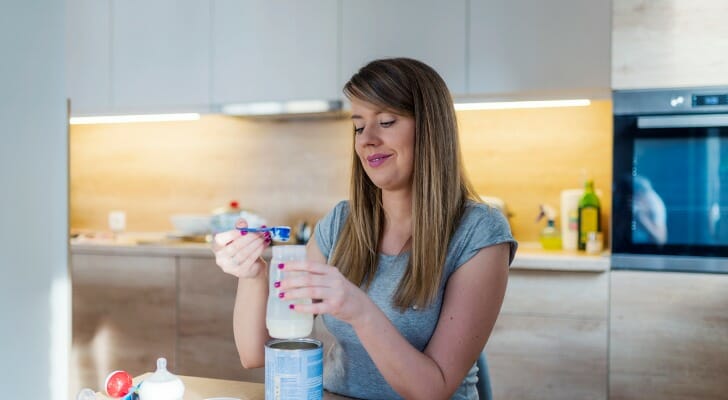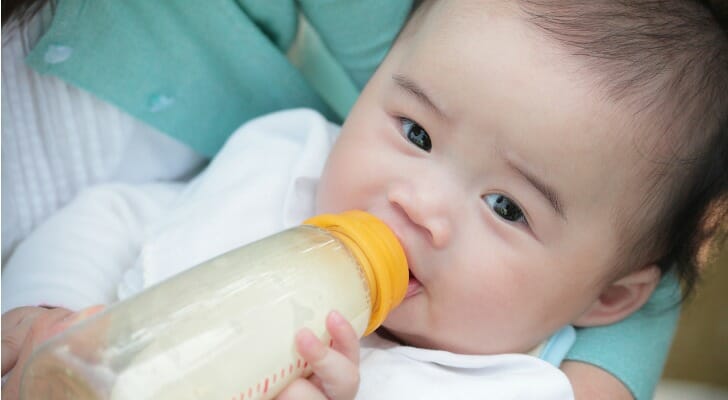The cost of baby formula in the U.S. has skyrocketed. In 2019, name brand baby formula cost American parents anywhere from 9 cents per ounce to 32 cents per ounce, but in 2024, the price of such products is in a range of 54 cents per ounce to $1.15 per ounce, potentially even higher if you’re not shopping at a discount outlet like Costco or Sam’s Club. Such costs and occasional issues with scarcity are driving some parents to buy generic brand formula from online vendors, turn to milk banks or just do without. Here’s why the cost of feeding a baby has shot up so dramatically, and how you can help manage it.
Consider working with a family-focused financial advisor who can guide you through these and other costs associated with the journey of raising a child.
Baby Formula Cost Per Month: A Breakdown
To understand the real cost of baby formula, the first step is to estimate how much milk your baby will need. Certified breastfeeding specialist Kelly Bonyata estimates babies consume an average of 25 ounces of milk per day during their first year.
Calculating the cost of baby formula will also require you to find out how much your preferred brand costs per ounce. Based on our research, you can expect to pay 54 cents per ounce for the cheaper brands. The higher-end brands will run you around $1.15 cents per ounce, or more.
If your baby currently consumes 25 ounces of milk per day, you can expect to spend between $821.25 and $2,920 in your baby’s first year. However, that does depend on the brand you choose.
Here’s how we calculated the cost of baby formula per year.
54 cents X 25 = $13.50
$13.50 X 365 = $4,927.50
$1.15 X 25 = $28.75
$28.75 X 365 = $10,493.75
If you want to figure out the cost of baby formula per month, simply take the price of baby formula you calculated for a year and divide by 12. Based on the above calculations, your monthly cost is going to range from about $411 to about $874. If you’re buying from a milk bank, of which there are about 30 in the U.S., expect to pay about $6,000 per month.
Other Considerations
Now, whether the infant formula you purchase is worth the cost depends on your individual situation and preferences. But now that you know what to expect, you can calculate your budget to account for the cost of baby formula.
Of course, your baby would likely need more baby formula in the middle of their first year of life as they grow, before gradually cutting back as they start eating more solid food.
To give you a better picture of how the cost of baby formula will fluctuate over time, the table below from Bonyata breaks down the recommended ounces of milk a baby should consume throughout their first year.
Daily Amount of Baby Formula Required in Ounces
| Baby’s Age | Minimum | Maximum |
| 0 weeks – 2 months | 14 – 21 | 28 – 32 |
| 2 – 6 months | 24 | 40 |
| 6-9 months | 24 | 32 |
| 9 -12 months | 18 | 32 |
But price shouldn’t be the only factor you’re weighing when it comes to choosing the right baby formula for your child. Some types may be vastly healthier than others.
Why Baby Formula Is Scarce
There are only four major baby formula producers in the United States. And one of them, Abbott Laboratories, accounts for a little more than 40% of the supply. After a whistleblower complaint following a few instances of babies getting sick, the FDA ordered Abbott to suspend production until it could verify that there were no contaminants. The administration also unveiled a website for parents seeking formula.
One reason for the concentration of formula producers is because of protective tariffs, up to 17.5%, on imports. Critics also assert that FDA labeling and ingredient requirements dissuade non-U.S. producers from entering the domestic market. Another factor is the Special Supplemental Nutrition Program for Women, Infants and Children (WIC) for low-income mothers. About half of all baby formula in the U.S. is purchased with WIC benefits. However, the range of brands available using WIC benefits is limited, something the administration says it is working to broaden.
Why Cheaper Generic Baby Formula Isn’t Always Better

When it comes to saving money on the products we need, we sometimes resort to generic versions to save a few dollars or cents. But you want the best for your child’s health. And the cheapest baby formula on the shelf may not help you achieve this goal.
Several companies offer organic baby formula with no added sugars. One example is Huggable.
In fact, the U.S.-based company says its products are from European countries where regulations around the ingredients used in baby formula are a lot stricter than in the U.S. Huggable’s prices compare to the costs of the higher-end brands on American shelves. But the company aims to justify the cost through its potential health benefits.
“A lot of the baby formulas you’ll find in the U.S. use high fructose corn syrup, glucose syrup solids or just plain sugar as the base for the carbohydrate,” Huggable CEO Madhu Punjabi said. “It’s no mystery, then, why there’s a childhood obesity and diabetes epidemic right now in the U.S.”
The main carbohydrate in breast milk is lactose. Punjabi added that a high quality formula would ideally try to mimic breast milk as close as possible.
“High-quality formulas should be based on organic cow’s milk or organic goat’s milk, because, like breast milk, these have lactose as their carbohydrate base, instead of sugars,” she said.
Huggable and similar infant formulas also contain probiotics, which experts at the Cleveland Clinic say can reduce the amount of infection- and inflammation-causing bacteria in your baby’s gut.
The Huggable website notes that with “nearly 1 in 5 children in the U.S. having obesity, it’s never been more important to carefully read the ingredients list of the formula you choose for your little one to make sure it doesn’t contain added sugar.”
But while weighing the costs and health benefits of different baby formulas, some may consider not going down the formula route at all to nourish their children. Many nursing mothers, of course, subscribe to the idea that “breast is best.” Organizations like the American Academy of Pediatrics and the World Health Organization recommend exclusively breastfeeding for the first six months of a child’s life. It’s often touted as a money-saving option, because the milk is free. But breastfeeding is not without costs of its own.
The Costs of Breastfeeding vs. Formula
For various reasons, some women may not be able to breastfeed their children. And those who can may need help, which can cost money. For instance, you may need a lactation consultant. A home visit from this expert lasting about two hours can cost several hundred dollars. A single office visit can also climb to $350. It’s a good idea to check with your health insurance, as some or all of this cost may be covered.
You may also need the following, though these products are not always necessary:
- Nursing bra: Starting at about $12
- Hand pumps: $5 to $35
- Nursing shirt: Starting at about $10
- Double electric pump: $120 to $350
- Nursing dress: Starting at about $20
- Nursing pillow: $10 to $50
In addition, this doesn’t factor in the cost of a breastfeeding mother’s time. This includes the economic loss that breastfeeding may take depending on your profession. If you earn sales commissions, for instance, the time you spend in the lactation room may diminish the amount of time you’re able to spend closing deals.
What’s Best for You and Your Baby?
So from an economic standpoint, which is best for you – breastfeeding or formula?
Remember, you can expect to pay $10,000 for higher-end baby formula in a year. The cost of breastfeeding is a lot harder to measure, however, because many of the costs are optional. And whether you require them depends on your individual situation.
But let’s say you have two at-home lactation consultations in a year, totaling $600. If you purchase all the products listed above without replacing them, you’re looking at a breastfeeding cost of $847 (we selected the most expensive choice for the products for which we reported price ranges).
Without taking into consideration the cost of a breastfeeding mother’s time, this estimation shows breastfeeding is about 30% the cost of formula. Ultimately, the decision is yours based on time, physical ability, health considerations, personal preferences and money.
How to Save on Baby Formula
Because some mothers may find breastfeeding difficult, time consuming or even impossible, they want to make sure they are making the right choice when it comes to formula. They also want to be mindful of their wallet when deciding on their brand of choice. But if you use baby formula, there are plenty of ways to slash the price tag. After all, the cost of raising a child is high enough.
“Always buy in bulk, and make sure you have a list when you walk into the grocery store,” said Neale Godfrey, a financial literacy expert.
She added that this list should prioritize the items you need for your baby. For instance, organic products that you need would go at the top. Lists are useful to have when you’re browsing the aisles, but they can be especially handy while you’re shopping online. That way, you make sure you’re getting all that you need and watching your budget.
Tips and Tricks to Save
Here are some additional tips to reduce the price of baby formula:
- Comparison shop online: E-commerce websites don’t have the same overhead as physical stores. As such, they can often reduce the price of your favorite baby formula – especially when you buy in large quantities.
- Buy in bulk: These days, you can find several stores and websites that offer discounts when you buy baby formula in bulk. While there, you can also cut down on other products you need for your baby.
- Use coupons: While you can still clip paper coupons from the Sunday paper, the internet is loaded with websites dedicated to coupons. You can also download apps onto your phone that can find baby formula coupons for you.
- Ask your doctor for free samples: Major brands often provide doctors with free batches of their products. Ask if your doctor has some on hand.
- Sign up for mailing lists: If you visit your favorite infant formula brand’s website, you can likely sign up for a mailing list. Companies often send welcome packages with free samples. And you can get coupons and other discounts sent to you periodically.
- Use powdered formula: Across brands, powdered infant formula tends to be cheaper than liquid forms.
- Check with your insurance provider: If your baby needs a specific kind of formula, your insurance provider may cover it. Depending on which type of health insurance you have, you can open a health savings account (HSA). These help you invest for your baby’s medical expenses while enjoying unique tax breaks.
- Earn rewards: If you’re using your credit card to purchase baby formula, you can earn some money while doing it. Shop around for the best cash-back credit cards. Some of the best checking accounts around offer this perk as well. Even 1.5% cash-back on purchases can put some significant money back in your pocket over time.
- Look into WIC: Depending on your circumstances, you may qualify for government assistance. Women, Infants and Children (WIC) provides federal grants to states. Their services help low-income women who are pregnant, breast-feeding or using formula access food and healthcare.
Bottom Line

Feeding your baby can be costly, whether breastfeeding or providing formula. Baby formula costs can rise especially high, but there are plenty of ways you can save. Try buying in bulk, surfing the web for deals and asking your doctor for free samples. Cost shouldn’t be the only factor that determines the type of baby formula you use. The formula you select can affect the health of your child. It’s important to pay close attention to the ingredients in that formula to capture a true picture of the cost and benefit of the food you provide for your child. It’s a good idea to discuss your decision with your child’s pediatrician.
Tips to Save for Your Child’s Future
- The average cost of raising a child through age 17 is close to a quarter of a million dollars a year, according to a recent report by the U.S. Department of Agriculture. But there are plenty of ways to save and invest in your child’s future, including getting professional help. Finding a qualified financial advisor doesn’t have to be hard. SmartAsset’s free tool matches you with up to three financial advisors who serve your area, and you can interview your advisor matches at no cost to decide which one is right for you. If you’re ready to find an advisor who can help you achieve your financial goals, get started now.
- If you just had a baby, you may be concerned about what the costs of college may be when your little one is ready to leave the nest. But you can start preparing now by opening a 529 college savings plan. These help you invest in your child’s future college expenses while you enjoy some tax breaks. Each state sponsors at least one, and most require no minimum contribution. We also published a report on all you need to know about college savings plans.
Photo credit: ©iStock.com/Laikwunfai, ©iStock.com/jubaphoto, ©iStock.com/pinstock
Disclosure: SmartAsset prepared this post in partnership with Huggable.
